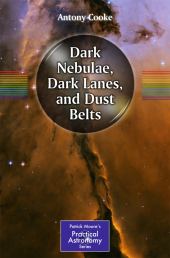 Neuerscheinungen 2012Stand: 2020-01-07 |
Schnellsuche
ISBN/Stichwort/Autor
|
Herderstraße 10
10625 Berlin
Tel.: 030 315 714 16
Fax 030 315 714 14
info@buchspektrum.de |

Antony Cooke
Dark Nebulae, Dark Lanes, and Dust Lanes
Observing Shadows in the Sky
2012. xi, 243 S. 75 SW-Abb. 235 mm
Verlag/Jahr: SPRINGER, BERLIN 2012
ISBN: 1-461-41185-8 (1461411858)
Neue ISBN: 978-1-461-41185-7 (9781461411857)
Preis und Lieferzeit: Bitte klicken
Dark Nebulae, Dark Lanes, and Dust Lanes looks out into the deep sky to see "the spaces between the words..."
While not usually considered independently, many of the apparent dark voids in space are among the most compelling telescopic destinations. One well-known example is Barnard s dark nebulae those striking dark clouds set against (and strikingly obscuring) the background of stars in the Milky Way but there are countless other less-discussed varieties. Among the brightly illuminated cosmic spectacles that easily come to the astronomer s mind with few exceptions, such as with the Horsehead Nebula (IC434) these dark regions are often ignored or commented upon only generally. Because they are only seen via the illuminated matter surrounding them, it is all too easy to overlook the treasure trove they offer the observer, and they frequently comprise much of what is likely to be considered of primary interest in illuminated space objects.
We can find dark voids obscuring all kinds of subjects. Within, or perhaps in front of, globular star clusters, many remarkable and complex dark lanes can be observed with just a little care. These features the spidery lanes of unlit gases and dust contribute much of the spectacle and differences from cluster to cluster. Perhaps the same is even more true with bright nebulae, the swirling and complex curtain shapes of illuminated matter, often only appearing to be formed in this manner because of the dark gas and dust within them or in between them and us. Similarly, while the dust belts/bands surrounding most galaxies have been described with a little more detail in practical astronomy sources, observers are often left in the dark [no pun intended] when it comes to anticipating more specifics of what might actually be seen, especially how to make sense of it. Many observers never realize the vast potential that exists for viewing this galactic aspect alone.
While mention of such characteristics is made in a few of the available books, detailed visual references and descriptions for the observer with the kind of detail an observer needs, for a wide range of sights from cluster to cluster, nebula to nebula, or galaxy to galaxy, do not exist: certainly not in a book dedicated just to these types of phenomena. Such illustrations as there are in existing sources usually emphasize the primary lit portions of the object, so that much of the dark regions are lost in the overexposure and lost to the discussion. While revealing the full dimensions and splendor of the objects, they often obliterate all the delicate inner structures. Typically, there is little discussion of most of these features in any of these resources, even when the effort has been made to provide viewing guidance.
All dark voids may be successfully observed using conventional observing methods, but because dark gases and dust usually present a strong infra-red spectrum they are often better seen with different technologies, including certain light-pollution filters, CCD video cameras and image intensifiers, which feature a response skewed to this portion of the spectrum. Dark Nebulae, Dark Lanes, and Dust Lanes explains the optimal ways to observe each object in detail.
To find a resource for this kind of information in one volume alone is yet to be realized. Uniquely, this new book provides a readily applicable, focused source of practical information from an observer s point of view for a fascinating area of practical observing.
Introduction. - The Nature of Unlit Gases and Dust, and their place in the Universe. - Observing Methods and Equipment. - Dark Lanes in Star Clusters. - Dark Lanes in Diffuse Nebulae.- Barnard´s Dark Nebulae. - Galactic Dust Belts, and other Dark Regions. - Catalog and Guide. - Appendices.


